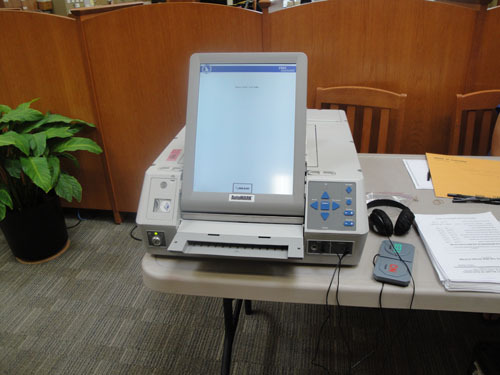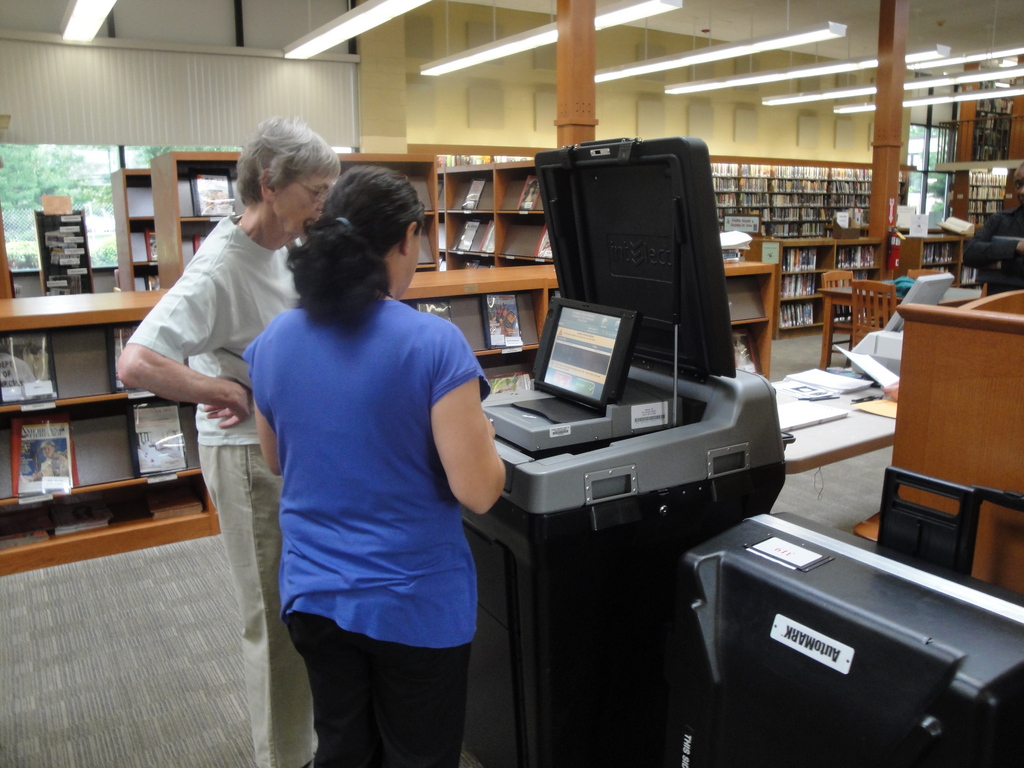New voting machines debut in September
Valley Stream residents get demo at Waldinger Library
The Nassau County Board of Elections held a demonstration of the new optical scan electronic voting machines at the Henry Waldinger Library on July 13. The new equipment will be used for the first time in the 2010 September primary and November general elections, as part of a federal mandate.
The Election Systems and Software DS200 Digital Scan System, one of the new voting machines, is a voter activated paper ballot counter and vote tabulator that functions differently than last year’s Sequoia/Dominion’s ImageCast ballot marking device.
The DS200 has a touch screen which is used to provide voters with feedback such as an over vote or under vote warning. An over vote notification is given when a person exceeds the number of selections allowed. An under vote occurs when the number of candidates chosen by a voter is less than the maximum allowed, or when no selection is made. On Election Day, the voter will receive a pre-printed paper ballot and a privacy sleeve from the election inspectors.
While in a privacy booth the voter must mark their desired candidates on the ballot with a pen. Voters are given the chance to write-in a candidate whose name does not already appear on the ballot in the last box at the bottom of every office.
They will then place the ballot inside the privacy sleeve and return to the table where they signed in their poll book. After, they will position the privacy sleeve against the scanner slot and the machine will automatically pull in the ballot.
The DS200 gives the voter a chance to review their votes. If, for example, the voter chooses to change their ballot and correct errors, they will press the “Don’t Cast – Return” option on the screen. If everything is correct, the voter will press the “Cast Ballot” option which will complete their vote. The state law allows for three ballots to be filled out per person if any mistakes are made.
“I like it better than the old one. It’s easier, much easier,” said Virginia Drummond, who came to watch the DS200 demonstrations at the Valley Stream library.
Regular procedures are followed after the poll closes such as vote tallies being printed out on a paper tally and sent to election officials.
New voting system machines are being used this year since last year’s all-in-one scanner and ballot marker experienced some problems. “The ImageCast was problematic in that the inspectors found it difficult to set up,” said Eleanor Sciglibaglio, director of voter education and outreach. For example, she said, the heavy LCD screen arrived at the polls face down and the inspectors had to lift it and swing the arm which had electrical connections on it, up and toward a voter, then attach a privacy screen. With all that happening, several arms and wires broke.
Amongst many difficulties that the Nassau Board of Elections experienced with the ImageCast were some with the printer. “The ballot was not pre-printed and therefore, the machine required a print cartridge,” said Sciglibaglio. “BOE technicians had to sprinkle water on the cartridges to get them going from year to year, or completely replace the (expensive) cartridge.” Not many people used the ballot marketing device last year which caused the cartridges to dry.
“The printer was an off-the-shelf HP – which sounded good as a selling point since one could always find a replacement in a hurry from, say, Staples,” Sciglibaglio said about another printer issue. “However, HP discontinued the model.”
Additionally a reason why they changed machines was because, “It’s a federal mandate. It’s a HAVA law,” said Sciglibaglio. According to the Help America Vote Act of 2002 which former President Bush signed, states were provided with funds to replace existing voting machines.
The Election Reform and Modernization Act of 2005 was passed in New York State. It authorized lever machines to be replaced by September 2007. According to the HAVA voting system standards, states must have abided with the standards by Jan 1, 2006, and all systems purchased must have met disability access standards by Jan 1, 2007.
The state made the lever machines illegal as of Sept 1, 2007. Nassau County chose the Sequoia ImageCast on Feb 8, 2008, as their selection. The ES&S AutoMARK, a paper ballot marking device, operates much like the ImageCast. The AutoMARK possesses features to assist voters who are blind, vision-impaired or have a disability that would make it difficult for them to mark a ballot.
Some of the functions it is equipped with are an LCD touch screen, an audio ballot reading function with headphones, a sip/puff tube, a zoom feature, change of contrast, multiple language capability and it is compatible with the DS200.
Unlike the DS200, the AutoMARK marks the ballot with the candidates chosen through the options a person may choose. After the ballot is marked, it scans through the DS200 and the same procedures are followed. Assistance is available for those with disabilities.
The AutoMARK consented with the federal HAVA accessibility for people with disabilities requirement.
Ed Griffin, the HAVA demonstrator, said the new machines are “much more easier, much more user friendly. The other machine we had was not user friendly.”
“I felt that the old machines worked well,” said Claire Lenz, an onlooker at the demonstrations. “I don’t see any need for replacement.” She added it can be financial abuse replacing the machines and there might be some glitches, however she is someone who likes technology. “I’m always looking for the next thing.”
The Nassau County Board of Elections has visited, and will continue to visit, different locations in Nassau County with demonstrations of the new voting machines. They will make an appearance at the Eisenhower Park in East Meadow, Glen Cove Chamber of Commerce, Oceanside Park, the Jones Beach Bandshell in Wantagh and many more.

 44.0°,
Mostly Cloudy
44.0°,
Mostly Cloudy 







